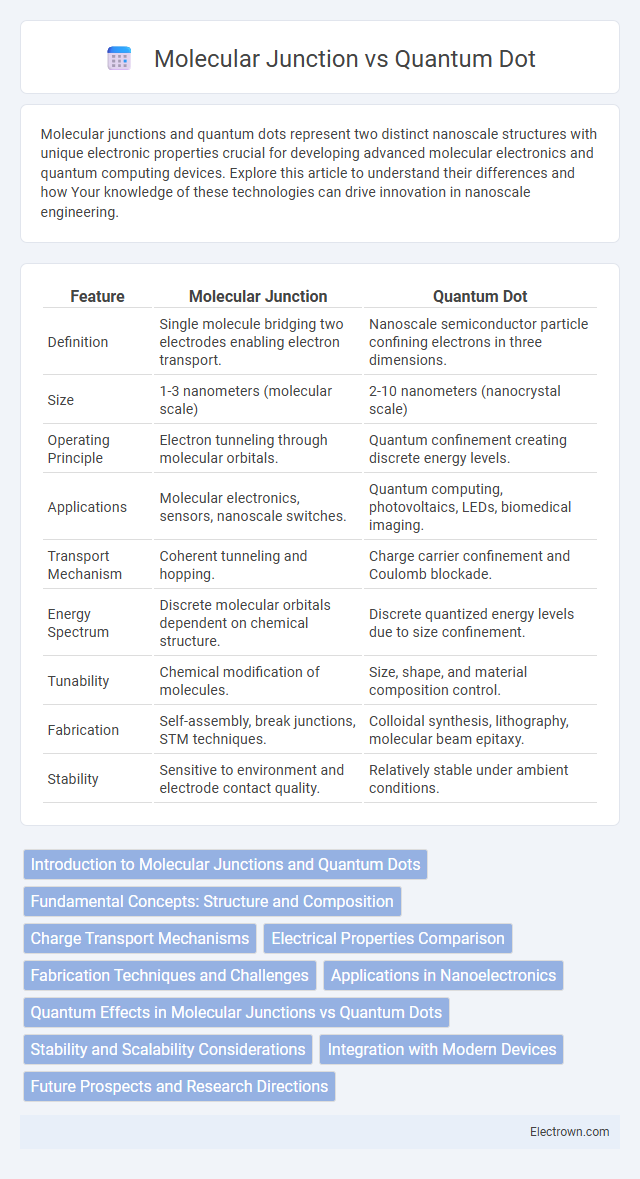Molecular junctions and quantum dots represent two distinct nanoscale structures with unique electronic properties crucial for developing advanced molecular electronics and quantum computing devices. Explore this article to understand their differences and how Your knowledge of these technologies can drive innovation in nanoscale engineering.
Table of Comparison
| Feature | Molecular Junction | Quantum Dot |
|---|---|---|
| Definition | Single molecule bridging two electrodes enabling electron transport. | Nanoscale semiconductor particle confining electrons in three dimensions. |
| Size | 1-3 nanometers (molecular scale) | 2-10 nanometers (nanocrystal scale) |
| Operating Principle | Electron tunneling through molecular orbitals. | Quantum confinement creating discrete energy levels. |
| Applications | Molecular electronics, sensors, nanoscale switches. | Quantum computing, photovoltaics, LEDs, biomedical imaging. |
| Transport Mechanism | Coherent tunneling and hopping. | Charge carrier confinement and Coulomb blockade. |
| Energy Spectrum | Discrete molecular orbitals dependent on chemical structure. | Discrete quantized energy levels due to size confinement. |
| Tunability | Chemical modification of molecules. | Size, shape, and material composition control. |
| Fabrication | Self-assembly, break junctions, STM techniques. | Colloidal synthesis, lithography, molecular beam epitaxy. |
| Stability | Sensitive to environment and electrode contact quality. | Relatively stable under ambient conditions. |
Introduction to Molecular Junctions and Quantum Dots
Molecular junctions consist of single molecules or small groups of molecules sandwiched between two conductive electrodes, enabling electron transport at the nanoscale. Quantum dots are semiconductor nanocrystals with unique electronic properties due to quantum confinement, allowing discrete energy levels and size-tunable emission spectra. Both molecular junctions and quantum dots play crucial roles in nanoelectronics and optoelectronics, offering distinct mechanisms for charge transport and light-matter interaction.
Fundamental Concepts: Structure and Composition
Molecular junctions consist of individual molecules chemically bonded to metal electrodes, forming a nanoscale bridge that facilitates electron transport primarily through molecular orbitals. Quantum dots are semiconductor nanocrystals with discrete energy levels arising from quantum confinement, typically composed of materials like CdSe or PbS, encapsulated within a ligand shell to stabilize their structure. The key structural difference lies in molecular junctions relying on specific chemical bonds for conduction, while quantum dots depend on quantum confinement effects within a defined crystalline lattice.
Charge Transport Mechanisms
Charge transport in molecular junctions primarily occurs via tunneling or hopping through discrete energy levels of the molecule bridging the electrodes. In contrast, quantum dots exhibit charge transport dominated by Coulomb blockade and quantum confinement effects, resulting in discrete conductance peaks during electron tunneling events. Understanding these mechanisms is crucial for designing nanoelectronic devices with tailored electrical properties.
Electrical Properties Comparison
Molecular junctions exhibit electrical properties characterized by electron tunneling through individual molecules, resulting in highly sensitive conductance dependent on molecular structure and environment. Quantum dots demonstrate discrete energy levels allowing for quantized conductance and Coulomb blockade effects, leading to size-tunable electrical behavior. Understanding these differences helps you tailor nanodevices with specific electrical characteristics for applications in molecular electronics and quantum computing.
Fabrication Techniques and Challenges
Molecular junctions are typically fabricated using techniques such as self-assembled monolayers (SAMs) and break junction methods, requiring precise control over molecular alignment and stable electrode-molecule contacts, which pose significant challenges in reproducibility and scalability. Quantum dots are commonly produced via colloidal synthesis, molecular beam epitaxy, or lithographic patterning, with challenges centered on achieving uniform size distribution, surface passivation, and integration into electronic devices. Both molecular junctions and quantum dots face difficulties in maintaining structural integrity and consistent electronic properties at the nanoscale during device fabrication.
Applications in Nanoelectronics
Molecular junctions serve as critical components in nanoelectronics by enabling electron transport through individual molecules, making them ideal for applications such as molecular switches, sensors, and memory devices. Quantum dots offer unique quantum confinement effects, which are exploited in applications like quantum computing, single-electron transistors, and light-emitting diodes (LEDs). Both molecular junctions and quantum dots enhance device miniaturization and functionality in next-generation nanoelectronic circuits.
Quantum Effects in Molecular Junctions vs Quantum Dots
Quantum effects in molecular junctions arise from electron tunneling through single molecules, exhibiting phenomena like Coulomb blockade and quantum interference, which influence their conductance properties at the nanoscale. Quantum dots display discrete energy levels due to quantum confinement, leading to size-dependent optical and electronic behaviors such as quantized charge states and photoluminescence. Understanding these distinctions helps optimize your nanoscale device designs by leveraging the unique quantum transport mechanisms inherent in each system.
Stability and Scalability Considerations
Molecular junctions exhibit limited stability due to susceptibility to environmental fluctuations, which challenges their reproducibility in large-scale applications. Quantum dots demonstrate enhanced stability with well-defined electronic properties controlled by size and composition, supporting better scalability for device integration. However, scalability in quantum dots depends on uniform synthesis techniques, whereas molecular junctions face difficulties in consistent assembly and contact formation at the nanoscale.
Integration with Modern Devices
Molecular junctions offer exceptional scalability and seamless integration with nanoscale electronic circuits, enabling efficient charge transport in modern molecular electronics. Quantum dots, with their discrete energy levels and tunable optical properties, are extensively used in advanced optoelectronic devices such as quantum dot LEDs and solar cells. Both technologies complement each other in developing next-generation devices by combining molecular-scale conductivity with quantum confinement effects for enhanced performance.
Future Prospects and Research Directions
Molecular junctions and quantum dots both hold transformative potential for next-generation nanoelectronics, with molecular junctions poised to revolutionize ultra-miniaturized circuits through precise electron transport control at the molecular level. Quantum dots offer promising applications in quantum computing and photonics due to their discrete energy levels and tunable optical properties, driving intensive research into enhanced coherence times and scalable fabrication techniques. Your understanding of these technologies' future prospects rests on breakthroughs in material synthesis, interface engineering, and integration strategies that will define their roles in quantum information processing and molecular-scale devices.
Molecular Junction vs Quantum Dot Infographic

 electrown.com
electrown.com